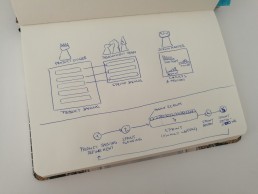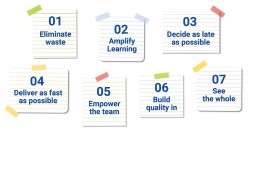Velocity
The performance of a team is measured by the stories the team completed in the last Sprint.
This performance is called “Velocity”.
When working with Story Points we can calculate this velocity by summing up all Story Points of completed Stories.
Otherwise we just take the number of Stories. Of course this is less accurate because there are always bigger stories and smaller stories.
Release Plan
I am text block. Click edit button to change this text. Lorem ipsum dolor sit amet, consectetur adipiscing elit. Ut elit tellus, luctus nec ullamcorper mattis, pulvinar dapibus leo.
Release Planning Meeting
I am text block. Click edit button to change this text. Lorem ipsum dolor sit amet, consectetur adipiscing elit. Ut elit tellus, luctus nec ullamcorper mattis, pulvinar dapibus leo.
SCRUM process
The SCRUM Process is like this for each Sprint:
- Sprint Planning Meeting
- Sprint with Daily SCRUM Meetings
- Sprint Review Meeting
- Sprint Retrospective Meeting

Definition of Done
To complete an item from the Product Backlog or an Product Increment it is important that there is a common understanding of what “Done” means within the project team.
Only when you defined what “Done” means, you can find out if work on an item or on the whole Product Increment is complete or not.
The definition od “Done” guides the Development Team in understanding how many items of the Product Backlog they can accomplish during a Sprint.
For achieving a high quality it is useful that the definitions of “Done” contain stringent criteria.
Acceptance Criteria
Acceptance Criteria are written in simple language, easy to understand – just like a User Story.
In the Sprint Review Meeting the Development Team demonstrate the functionality for all User Stories the have worked on to the Product Owner by showing how each Acceptance Criterion is fulfilled.
Acceptance Criteria belong to a User Story. This has several benefits:
- they make the Developement Team look through the user’s perspective
- they make requirements clear and concrete
- they indicate the tests that will confirm that a feature / a piece of functionality is working correctly and complete
Example
- The user can only send the form, when all mandatory fields are filled out.
- All information send by the form is stored in the database.
- Protection against spam must be given.
- The page loading time may not increase.
- The user must enter a valid credit card information.
- The user will receive a confirmation email after submitting the form.
7 core concepts of Lean
Lean leverages 7 core concepts:
- Eliminate Waste
- Amplify learning
- Deliver as fast as possible
- Decide as late as possible
- Empower the team
- Build quality in
- See and optimize the whole
The most important one and key success driver, according to my experience, is the following one:
Eliminate waste
So, check what of the following things you can remove at work:
- partially done work (at least consider this)
- extra procedures
- extra (not core) features
- to much task switching
- waiting times
- defects and things littered with mistakes
Kanban
Kanban is the Japanese word for “sign board”.
It is a task board way to vizualize the workflow and it is very easy to mark tasks with blocks during the Daily SCRUM.
In SCRUM the task board (KANBAN) has typically 6 columns:
- ToDo 1: Backlog (User Stories)
- ToDo: Tasks
- In Progress – 1: Developement
- In Progress – 2: Testing
- In Progress – 3: Deployment
- Done
But if you never worked with this before, you could easily start with this most simple board:
- ToDo
- Doing
- Done
…and then put in more details with each further project.
Details
Buy the way there are some things I like very much:
In KANBAN there are often 2 testers responsible to test a task.
You can introduce a “Priority Lane” e.g for stories / tasks that are very urgent.
Primarily a Kanban board is used in the Agile Methodology “Lean”, but also in SCRUM and XP (Extreme Programming) used.


